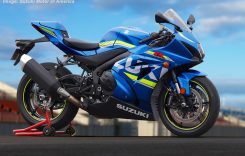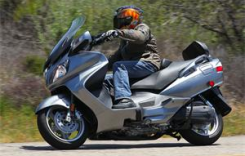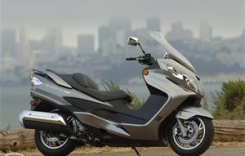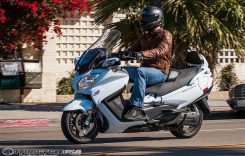


Suzuki re-tools its flagship GSX-R1000 sportbike for the 2017 racing season. The new bike features a redesigned engine, chassis, and a sophisticated electronics package.
Suzuki pulled the wraps off its top-of-the-line and liter-class sized GSX-R1000 superbike today at Italy’s EICMA motorcycle show. Although listed as a “concept”, we anticipate this being the machine Suzuki goes superbike racing with in 2017.
Last tweaked for the 2012 model year, the sixth-generation Gixxer 1000 sees its first complete overhaul in six years, employing an all-new 999cc Inline Four engine, chassis, bodywork, and high-end electronics package.
The new bike makes the jump to electronically controlled throttle bodies, replacing the GSX-R’s long-standing mechanical cable set-up. There’s little doubt this change complements Suzuki’s 10-level traction control system, that is adjustable, on the fly, while riding. Launch control programming is also included, which holds engine rpms at a certain threshold allowing for a more optimum race start when the clutch lever is released.
In current form, the GSX-R1000 certainly can’t be deemed heavy, however engineers focused on making it the lightest 1000 they’ve ever assembled. “Run, turn, stop handling” and “rider feel” were also primary design goals.
Anti-lock-equipped Brembo brakes and a electronic quickshifter round out the GSX-R1000’s electronics package. Suzuki’s long-standing S-DMS power mode selector returns as well, which allow for different power maps based on rider preference, or road conditions. An all-digital dash display keeps tabs on the motorcycle’s vitals and various electronic settings.
Although Suzuki hasn’t disclosed exact technical specifications, it says that its new engine will feature variable valve timing — a technological first for a superbike engine. This allows the camshafts to operate at different profiles, based on engine load, allowing for optimum engine efficiency across the rev range. Another key change is the switch from the GSX-Rs classic bucket-tappet valve actuation to a finger follower rocker arm set-up which enhances control, especially at high rpms (modern production Inline Four superbikes engines rev to around 14,000 rpm currently).
Like before the Inline Four receives fuel from a pair of primary, and secondary fuel injectors (eight total), however the second set have been re-positioned atop the airbox. On the exhaust side, both header balance tubes use a butterfly valve to modulate engine back pressure for more power.
Suspension-wise the flagship GSX-R uses Showa’s latest Balance-Free Fork, which introduces authentic Superbike and MotoGP racing suspension technology with external nitrogen-filled reservoirs to provide greater damping consistency as the oil heats. A matching Balance-Free Rear Cushion shock absorber has also been adopted.
No word on pricing, or an official release date, but its fair to presume that this will be a 2017 model for U.S. customers.
Suzuki hasn’t released official technical specifications but they proudly tout a number of mechanical hardware changes including variable valve timing, and new valve actuation configuration










